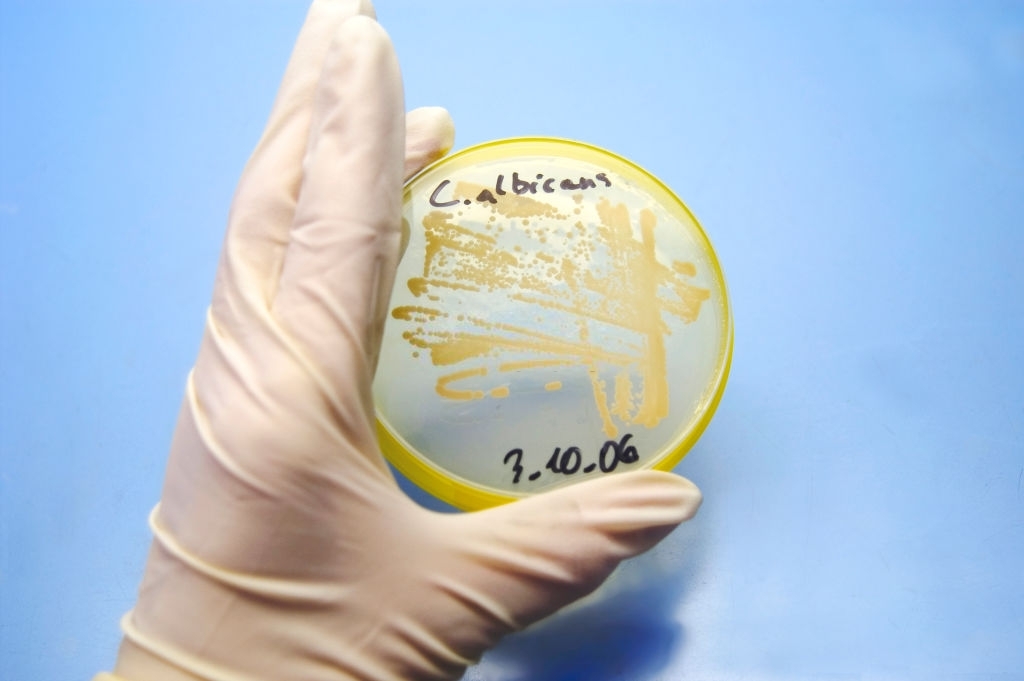Candidiasis are infections caused by fungi of the genus Candida , the most common species being Candida albicans . Candida is saprophytic, it exists in healthy humans in the mucous membranes of the oral, vaginal and intestinal cavity. These infections can occur in both healthy and immunocompromised subjects . Digestive yeast infection or intestinal candidiasis is a disorder caused by the excessive presence of candida albicans . They can colonize the entire digestive tract, from the mouth to the anus.
What is Candida albicans ?
The candida albicans is a yeast-like fungus , naturally present in the body. It is therefore one of the microorganisms that inhabit the intestinal microbiota (or intestinal flora). In the normal state, it protects us from infections and participates more generally in cleaning our intestines .
When the gut microbiota is out of balance, candida albicans can overgrow in the digestive tract and release toxins. The repetitive intake of certain drugs such as antibiotics, as well as a diet too rich in refined sugars, can be the cause of this inconvenience.
Recurrent or chronic digestive candidiasis
Harmless at first glance, candidiasis is indeed a frequent infectious disease which affects 1/3 of the population in France, and which can end up constituting a very disturbing health problem, sometimes disabling. The multiplication of candida- type yeasts can in particular affect all areas of the body such as the skin, nails or mucous membranes.
C. albicans is a “velcro pathogen”: it “attaches” itself firmly and, as soon as it has deployed its network of mycelial filaments, it is very difficult to detach it, constituting aggressive pathogenic biofilms on the surface of the mucous membranes. It secretes toxic substances, at least 35 toxins, enzymes which will degrade their environment (candidin, tartaric acid, acetaldehyde, etc.).
Are there factors favoring digestive candidiasis?
Esophageal candidiasis occurs mainly during immunosuppression (HIV, immunosuppressive treatments, inhaled or systemic corticosteroids, diabetes and neoplasia) or in the presence of risk factors in apparently immunocompetent patients (broad-spectrum antibiotic therapy, PPI, functional or structural abnormality of the liver). ‘esophagus). PPIs, especially omeprazole , should be used with caution in immunosuppressed patients.
More generally, the diagnosis of esophageal candidiasis should also be suspected in a patient presenting with gastritis symptomatology that does not yield under PPI treatment. Occasionally, the infection may occur in patients without recognized risk factors or immunosuppression (antimitotics, oral contraceptives, pregnancy, local factors such as humidity, heat, sweating and poor hygiene).
The different types of digestive candidiasis
There are several types of candidiasis of the digestive tract depending on their location along the digestive tract :
Oral candidiasis:
-
Thrush (acute stomatitis):
Common in newborns, it is a whitish creamy coating that is found on the inside of the cheeks.
-
Erythematous glossitis:
It manifests as a bright red tongue with a burning sensation.
-
The black hairy tongue:
It is an enlarged papillae of the tongue with black pigmentation.
-
Perlèche:
It is an extreme dryness of the corners of the lips resulting in scabs as well as cracks.
Esophageal candidiasis:
We find difficulty in swallowing with a painful sensation, burning, hiccups as well as nausea.
Gastrointestinal candidiasis:
There is frequent diarrhea and ulcerations of the intestinal mucous membranes.
Anal candidiasis:
It is a pruritus with a sensation of anal burning after stool emission.
Some naturopathic advice to limit digestive candidiasis
- Remove contributing factors when possible (antibiotics, corticosteroids, antacids, etc.)
- Reduce sugars and alcohol which promote the development of Candida .
- Perform antiseptic mouthwashes to prevent oral yeast infection.
- Regularly take a course of specialized anti-candida probiotics ( Lactobacillus gasseri LA806 , Lactobacillus helveticus LA401 candisis ).
- Favor an anti-candida type diet , low in products of industrial origin, in rapid sugars and in gluten.
Are there any medicinal plants to fight against digestive candidiasis?
To treat candida and disinfect the gut:
The herbal medicine treatment proposed is a mixture of extract of echinacea , licorice and walnut (against a background of loose or watery stools) or rosemary (if pain and spasms).
-
The antifungal action of Echinacea:
The polysaccharides improve in particular the resistance of immunocompromised subjects to systemic infections with Candida albicans , by modifying the structure of the parietal membrane of fungal cells .
-
The anti-infectious properties of Liquorice:
Glycyrrhin increases resistance in MAIDS subjects (subjects 100 times more susceptible to infections by Candida albicans than normal subjects) against infection with Candida albicans . Glabridin has been shown to be active against both yeast and filamentous fungi . It has also shown efficacy against mutated forms of drug-resistant Candida albicans , with an MIC of 31.25-250 µg / mL.
-
Antidiarrhoeal properties of walnut:
Walnut leaves are traditionally used in the symptomatic treatment of mild diarrhea . The advantage of the extract tested lies in its ability to inhibit diarrhea without completely blocking defecation, unlike the reference treatment ( loperamide ). It has also shown antinociceptive effects which have not been seen with loperamide . The particular properties of this extract have in fact been attributed to the presence of hydroxycinnamic acids (chlorogenic, neochlorogenic, 3-p- and 4-p coumaroylquinic acids) and flavonoids (mainly derivatives of quercetin, myricetin, kaempferol, and taxifolin). Some of these molecules present anti-inflammatory and antioxidant properties , and also have the ability to inhibit fluid and electrolyte secretions as well as half at the intestinal level.
In case of digestive candidiasis on carbohydrate ground (patient greedy for sugar):
The proposed herbal medicine treatment is a mixture of burdock extract , echinacea and licorice, in addition to an extract of griffonia , to curb sweet compulsions, especially at the end of the day.
-
Action on the carbohydrate metabolism of Burdock:
Confirming the traditional use of burdock root to reduce hyperglycemia , studies have shown that this plant limits the rise in blood sugar after ingestion of carbohydrates , by its supply of inulin and by activation of intracellular signaling of energy metabolism (AMPK). In addition, burdock is antistaphylococcal and antimycotic against Candida albicans .
-
Effect of 5-HTP on the feeding behavior of Griffonia:
In obese women (30 <BMI <40), taking 5-HTP compared to a placebo also allows a significant loss of weight with spontaneous decrease in the daily caloric intake (3220 Cal / d) and in particular of the carbohydrate intake (50% decrease).
Medical bibliographic sources and clinical trials :
- Steinmüller C, Roesler J, Gröttrup E, Franke G, Wagner H, Lohmann-Matthes ML. Polysaccharides isolated from plant cell cultures of Echinacea purpurea enhance the resistance of immunosuppressed mice against systemic infections with Candida albicans and Listeria monocytogenes. Int J Immunopharmacol. 1993
- Bauer caR, Hoheisel O, Stuhlfauth I, Wolf H. Extract of the Echinacea purpurea herb: an allopathic phytoimmunostimulant. Wien Med Wochenschr. 1999
- Abdulaziz M. Alkhawajah. Studies on the Antimicrobial Activity of Juglans regia. The American Journal of Chinese Medicine (AJCM), 1997
- Mark Feldman, Shinichi Tanabe, Amy Howell, Daniel Grenier. Cranberry proanthocyanidins inhibit the adherence properties of Candida albicans and cytokine secretion by oral epithelial cells. BMC Complementary and Alternative Medicine 2012
- Steinmüller C. et al., Polysaccharides isolated from plant cell cultures of Echinacea purpurea enhance the resistance of immunosuppressed mice against systemic infections with candida albicans and Listeria monocytogenes, Int J Immunopharmacol., 1993
- Utsunomiya T. et al., Glycyrrhizin improves the resistance of MAIDS mice to opportunistic infection of Candida albicans through the modulation of MAIDS- associated type 2 T cell responses, Clin Immunol., 2000
- Hemmerle H. et al., Chlorogenic acid and synthetic chlorogenic acid derivatives : novel inhibitors of hepatic glucose-6-phosphate translocase, J Med car Chem., 1997
- Cangiano C. et al., Effects of oral 5-hydroxy-tryptophan on energy intake and macronutrient selection in non-insulin dependant diabetic patients; Int J Obes Relat Metab Disord., 1998





